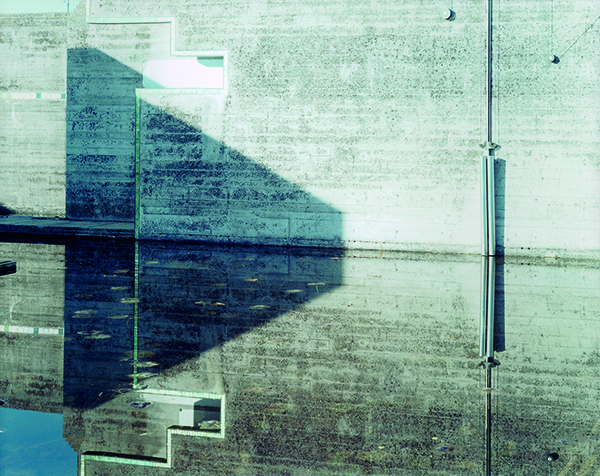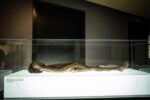Guido Guidi – Photographic Visions of Modernist Architecture

Le serie fotografiche presentate sono testimonianza di una visione rigorosa e chiara, ma allo stesso tempo spensierata e altamente poetica dell’architettura moderna.
Comunicato stampa
Guido Guidi (* 1941 in Cesena) ist bekannt als Pionier der italienischen Landschafts- und Architekturfotografie. Beeinflusst vom Neorealismus und der Konzeptkunst beschäftigte er sich in seinem Werk seit den 70er Jahren vor allem mit marginalisierten Räumen, mit Orten, Landschaften und Architekturen aus der Peripherie, die nicht im Zentrum unserer Aufmerksamkeit stehen. In seinen Fotografien sammelt er Spuren der Vergangenheit und der Gegenwart, und seine Werke erzählen von der Veränderbarkeit unserer Realität im Laufe der Zeit, sowie von der Transformation von Städten und Landschaften durch die Eingriffe des Menschen. In diesem Zusammenhang entwickelte er eine Bildsprache, die unseren visuellen Erkenntnisprozess anhand des Mediums der Fotografie reflektiert, indem sie die Veränderbarkeit und Sensibilität unserer eigenen Wahrnehmung hinterfragt.
Ab den 80er Jahren entstanden zahlreiche fotografische Serien, in denen Guido Guidi brutalistische Architekturen der Moderne dokumentierte. Die Galerie foto-forum vereint in einer Ausstellung die Präsentation von drei ausgewählten Fotoserien, nämlich von Fotografien aus „The Atlantic Wall“ (2005), einem umfangreichen fotografischen und architekturhistorischen Forschungsprojekt rund um eine der letzten großen Verteidigungslinien des 20. Jahrhunderts, den Bunkern an der Atlantikküste Nordeuropas, erbaut von den deutschen Besatzungsmächten in den Jahren 1941 bis 1944. Weiters zeigt die Ausstellung Fotografien des Fabrikgebäudes Usine Claude-et-Duval in Frankreich (2003), erbaut vom Meister der modernen Architektur Le Corbusier im Jahre 1951, dem einzigen je von Le Corbusier entworfenen Industriegebäudes. Und letztlich ist eine Auswahl von Fotografien aus dem Projekt „La tomba di Brion“ (1996-2006) zu sehen sein, dem Grabmal des Industriellen Giuseppe Brion, einem architektonischen Hauptwerk des Architekten Carlo Scarpa, erbaut zwischen 1970 -1978 im Friedhof San Vito in Altivole (Provinz Treviso), welches Guido Guidi in einem Zeitraum von 10 Jahren fotografierte.
Die präsentierten fotografischen Serien sind Zeugnisse eines rigorosen und klaren, gleichzeitig unsentimentalen und doch in höchstem Maße poetischen Blicks auf Bauwerke moderner Architektur. Es sind Bilder der Erinnerung, welche das Thema der vergehenden Zeit in den Fokus rücken, indem das Licht, die Veränderung der Farben, und der Lauf der Schatten in seriell angeordneten Fotoreihen das Fortschreiten des Tages und der Jahreszeiten kennzeichnen. Und gleichzeitig erlangt der abgebildete Gegenstand eine einzigartige Monumentalität und Unvergänglichkeit. Die Arbeiten können als Beispiele eines tiefen Verständnisses Guido Guidis für das Zusammenspiel zwischen Architektur und Landschaft, zwischen Vergangenheit und Gegenwart, und zwischen fragiler Vergänglichkeit und monumentalem Ewigkeitsanspruch gelesen werden.
it
Guido Guidi (* 1941 a Cesena) è noto come pioniere della fotografia paesaggistica e architettonica italiana. Influenzato dal Neo-realismo e dall’Arte Concettuale, fin dagli anni Settanta il suo lavoro si concentra principalmente sulle zone marginali, sui paesaggi e l'architettura della periferia, luoghi che non sono al centro della nostra attenzione.
Nelle sue fotografie raccoglie tracce del passato e del presente, le sue opere raccontano la mutevolezza della nostra realtà nel tempo, come la trasformazione di città e paesaggi attraverso l'intervento umano. In questo contesto ha sviluppato un linguaggio visivo che riflette il nostro processo di cognizione visiva attraverso il mezzo della fotografia, mettendo in discussione la mutevolezza e la sensibilità della nostra stessa percezione.
Dal 1960 in poi, Guido Guidi produce numerose serie fotografiche in cui documenta l’architettura modernista brutalista. La galleria foto-forum riunisce in un’unica mostra la presentazione di tre serie fotografiche selezionate, ovvero fotografie tratte da "The Atlantic Wall" (2005), un ampio progetto di ricerca fotografica e storico-architettonica intorno a una delle ultime grandi linee di difesa del XX secolo, i bunker lungo la costa atlantica del nord Europa, costruita dalle forze di occupazione tedesche negli anni 1941-1944.
La mostra presenta anche le fotografie dell’edificio industriale Usine Claude-et-Duval in Francia (2003), costruito dal maestro dell'architettura moderna Le Corbusier nel 1951, l'unico edificio industriale progettato da Le Corbusier. Infine, una selezione di fotografie tratte dal progetto "La Tomba Brion" (1997-2007), la tomba dell'industriale Giuseppe Brion, importante opera architettonica dell'architetto Carlo Scarpa, realizzata tra il 1970 e il 1978 nel cimitero di San Vito di Altivole (Treviso), che Guido Guidi ha fotografato per un periodo di 10 anni.
Le serie fotografiche presentate sono testimonianza di una visione rigorosa e chiara, ma allo stesso tempo spensierata e altamente poetica dell'architettura moderna. Sono immagini della memoria che si concentrano sul tema del tempo che passa, in cui la luce, il cambiamento di colore e il corso delle ombre segnano la progressione del giorno e delle stagioni. Allo stesso tempo, l'oggetto raffigurato acquisisce una monumentalità e immortalità uniche. Le opere possono essere lette come esempi della profonda comprensione di Guido Guidi per quanto riguarda l’interazione tra architettura e paesaggio, tra passato e presente, tra fragile transitorietà e monumentale eternità.
en
Born 1941, in Cesena, Italy, Guido Guidi is a renowned pioneering photographer of European architecture and landscapes. Influenced by Neo-Realism and Concept Art, he has focused since the 1970s primarily on marginalized spaces, those locations, landscapes and architectures on the periphery to which we generally pay little attention. In his photographs he gathers traces of the past and present, and his work speaks thus of shifts inscribed in our realities by time as well as of metamorphoses wrought in cities and landscapes by human intervention. Through the medium of photography he articulates in such settings a visual idiom that reflects our ways of seeing by scrutinising the changeability and sensitivity of our personal perceptions.
In numerous photographic series since the 1980s Guido Guidi has documented Brutalism in modern architecture. foto-forum has selected works from three of these for the present exhibition: from “The Atlantic Wall” (2005), a comprehensive record of one of the last major twentieth-century lines of defence, the bunkers built in the period 1941–44 by the German forces of occupation on the Atlantic Coast of northern Europe: an innovative series, in photographic terms, as well as an example of research into the history of architecture. Further, the exhibition presents a photo series from 2003 of the sole industrial design ever realised by the maestro of modern architecture, Le Corbusier: the Claude-et-Duval factory built in France in 1951. And finally, there is a selection of photographs from the project “Brion Cemetery, 1996–2006”, for which Guido Guidi portrayed over a ten-year period the family tomb of the industrialist Giuseppe Brion, an architectural masterpiece created from 1970 to 1978 by Carlo Scarpa, as an addition to the San Vito cemetery in Altivole in the province of Treviso.
These photographic series attest the artist’s rigorous, clear and unsentimental regard for works of modern architecture yet are simultaneously highly poetic. Mementos of the passage of time, they draw our attention to the fleeting and ephemeral, documenting through their sequentiality the shifts in light, changes in colour and lengthening of shadows that occur in the course of a day or over seasons; and the objects thus portrayed gain a unique monumentality and timelessness. The works may be read therefore as emblems of Guido Guidi’s profound understanding of the interplay between architecture and landscape, the past and the present, fragile transience and lofty claims to a world without end.



